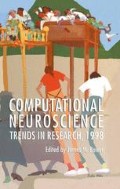Abstract
Despite intensive research over the past 30 years, the performance of artificial visual systems in object recognition is still poor when compared with humans. For humans, the identification of objects in natural scenes appears both effortless and fast. Just how fast was a question we addressed recently in a study that associated behavioral measurements and event related potential (ERP) recordings1. The task used was a go/no-go visual categorization task in which human subjects had to respond when a photograph of a natural scene contained an animal. The photographs had never been seen before and were flashed centrally on a screen for only 20 ms. Humans scored 94% correct, moreover, their ERPs recorded on animal and non-animal trials showed a clear difference on all frontal electrodes that started around 150 ms after stimuli onset. Thus, it appears that the human visual system can process such previously unseen complex natural scenes in less than 150 ms, a level of performance well above that of any currently available artificial system. This is despite the fact that the neurons that constitute the human visual system are relatively slow — firing rates rarely exceed 200 Hz, a value far slower than the transistors of a modern microprocessor, which can change state over a million times faster.
Access this chapter
Tax calculation will be finalised at checkout
Purchases are for personal use only
Preview
Unable to display preview. Download preview PDF.
References
SJ. Thorpe, D. Fize, and C. Marlot, Speed of processing in the human visual system. Nature 381: 520–522 (1996).
M.D. Rugg, M.C. Doyle, and T. Wells, Word and nonword repetition within-modality and across-modality. An event-related potential study. Journal of Cognitive Neuroscience 7: 209–227 (1995). 3.1. Biederman and E.E. Cooper, Object recognition and laterality: null effects. Neuropsychologia 29: 685-694 (1991).
M. Vitkovitch and G. Underwood, Visual field differences in an object-recognition task. Brain and Cognition 19: 195–207 (1992).
C.J. Downing, Expectancy and visuo-spatial attention: Effects on perceptual quality. Journal of Experimental Psychology: Human Perception and Performance 13: 228–241 (1988).
N. Lavie and Y. Tsal, Perceptual load as a major determinant of the locus of selection in visual attention. Perception and Psychophysics 56: 183–197 (1994).
C.W. Eriksen and Y.Y. Yeh, Allocation of attention in the visual field. Journal of Experimental Psychology: Human Perception and Performance 11: 583–597 (1985).
J.M. Henderson, K.K. McClure, S. Pierce, and G. Schrock, Object identification without foveal vision: Evidence from an artificial scotoma paradigm. Perception and Psychophysics 59: 323–346 (1997).
T.C. Handy, A. Kingstone, and G.R. Mangun, Spatial distribution of visual attention: Perceptual sensitivity and response latency. Perception and Psychophysics 58: 613–627 (1996).
SJ. Thorpe and M. Imbert, Biological constraints on connectionist models., in: Connectionism in Perspective., R. Pfeifer, Z. Schreter, F. Fogelman-Soulié, & L. Steels, eds., Elsevier: Amsterdam. 63–92. (1989).
B.A. Olshausen, C.H. Anderson, and D.C. Van Essen, A multiscale dynamic routing circuit for forming size-and position-invariant object representations. Journal of Computational Neuroscience 2: 45–62 (1995).
Author information
Authors and Affiliations
Editor information
Editors and Affiliations
Rights and permissions
Copyright information
© 1998 Springer Science+Business Media New York
About this chapter
Cite this chapter
Fabre-Thorpe, M., Fize, D., Richard, G., Thorpe, S. (1998). Rapid Categorization of Extrafoveal Natural Images: Implications for Biological Models. In: Bower, J.M. (eds) Computational Neuroscience. Springer, Boston, MA. https://doi.org/10.1007/978-1-4615-4831-7_2
Download citation
DOI: https://doi.org/10.1007/978-1-4615-4831-7_2
Publisher Name: Springer, Boston, MA
Print ISBN: 978-1-4613-7190-8
Online ISBN: 978-1-4615-4831-7
eBook Packages: Springer Book Archive

